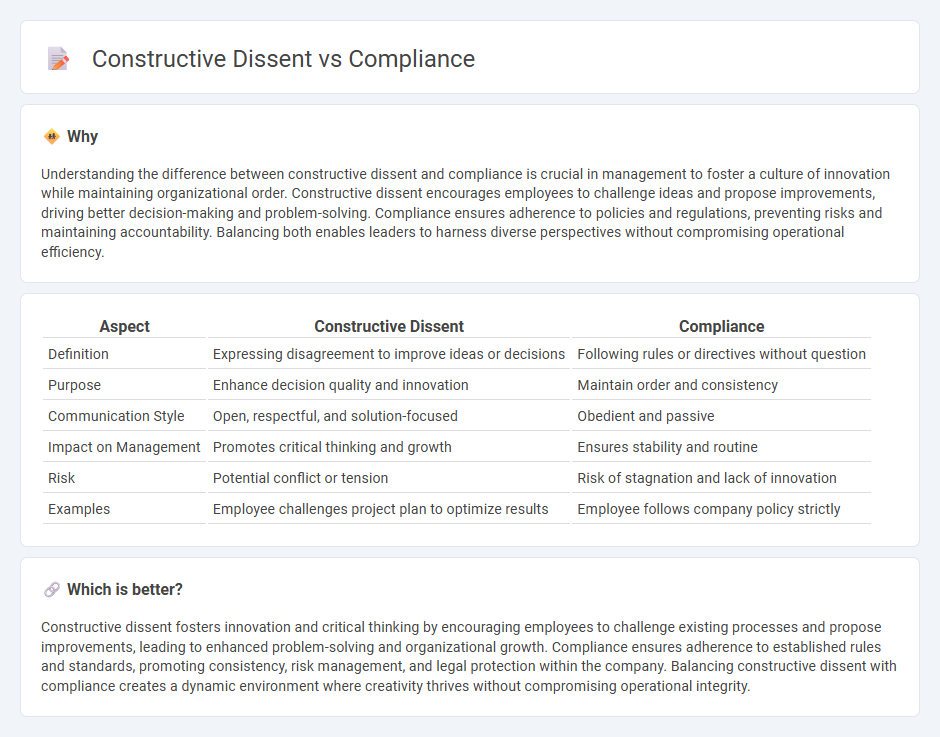
Constructive dissent encourages employees to voice alternative ideas and challenge decisions to foster innovation and improve organizational outcomes, while compliance emphasizes adherence to established rules and policies to maintain order and reduce risks. Effective management balances these approaches to promote a culture where diverse perspectives are valued without compromising operational consistency. Discover how implementing this balance can enhance team performance and organizational success.
Why it is important
Understanding the difference between constructive dissent and compliance is crucial in management to foster a culture of innovation while maintaining organizational order. Constructive dissent encourages employees to challenge ideas and propose improvements, driving better decision-making and problem-solving. Compliance ensures adherence to policies and regulations, preventing risks and maintaining accountability. Balancing both enables leaders to harness diverse perspectives without compromising operational efficiency.
Comparison Table
| Aspect | Constructive Dissent | Compliance |
|---|---|---|
| Definition | Expressing disagreement to improve ideas or decisions | Following rules or directives without question |
| Purpose | Enhance decision quality and innovation | Maintain order and consistency |
| Communication Style | Open, respectful, and solution-focused | Obedient and passive |
| Impact on Management | Promotes critical thinking and growth | Ensures stability and routine |
| Risk | Potential conflict or tension | Risk of stagnation and lack of innovation |
| Examples | Employee challenges project plan to optimize results | Employee follows company policy strictly |
Which is better?
Constructive dissent fosters innovation and critical thinking by encouraging employees to challenge existing processes and propose improvements, leading to enhanced problem-solving and organizational growth. Compliance ensures adherence to established rules and standards, promoting consistency, risk management, and legal protection within the company. Balancing constructive dissent with compliance creates a dynamic environment where creativity thrives without compromising operational integrity.
Connection
Constructive dissent fosters an environment where employees feel safe to voice concerns, leading to improved compliance by identifying potential risks early. Organizations with a culture of open communication can better adapt policies that align with regulatory standards and ethical practices. Encouraging constructive dissent ultimately strengthens governance and enhances overall organizational accountability.
Key Terms
Regulation
Compliance ensures strict adherence to regulatory requirements, maintaining organizational alignment with legal standards to avoid penalties and foster trust. Constructive dissent encourages critical evaluation and innovative thinking within regulatory frameworks, promoting improvements and adaptive risk management. Explore how balancing compliance with constructive dissent enhances regulatory strategies and organizational resilience.
Innovation
Compliance ensures adherence to established rules and procedures, fostering stability but often limiting innovative thinking. Constructive dissent encourages questioning norms and proposing alternative solutions, which fuels creativity and breakthroughs in innovation processes. Explore how balancing compliance with constructive dissent can drive transformative innovation within organizations.
Ethical Decision-Making
Compliance involves adhering strictly to established rules and regulations, ensuring ethical decision-making aligns with organizational standards and legal requirements. Constructive dissent encourages raising concerns and challenging unethical practices thoughtfully to promote transparency and integrity within decision-making processes. Explore deeper insights into balancing compliance with constructive dissent to enhance ethical outcomes in your organization.
Source and External Links
What is compliance? - TechTarget - Compliance is the state of being in accordance with established guidelines or specifications, addressing both industry regulations and government legislation.
What is Compliance: Definition, basics & tips to get started - Compliance means adhering to applicable rules and laws, including country-specific laws and internal company directives.
Compliance | Office of Inspector General - HHS.gov - The Office of Inspector General provides compliance resources to help healthcare providers comply with federal healthcare laws and regulations.
 dowidth.com
dowidth.com